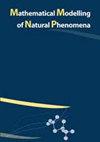宫颈管对精子液电渗力发展的行为反应
IF 2.1
4区 数学
Q2 MATHEMATICAL & COMPUTATIONAL BIOLOGY
引用次数: 39
摘要
本研究的目的是对电渗力对精子在整个宫颈管中游动的影响进行理论研究。为了模仿具有自推进精子的男性精液,使用双曲正切流体作为基础液体。游动的精子在有纤毛的宫颈管内移动,蠕动是由于有纤毛的壁而发生的。用摄动方法解析求解控制偏微分方程组。由于游泳者的自我推进和长波假设,整个溪流都采用了爬行流协议。流模式、速度分布和压力梯度(游泳板上方和下方)解决方案将与相关参数一起生成和显示。本文的结果表明,双曲正切流体的流变参数更适合于模拟和讨论宫颈液的运动。此外,粘液速度的运动性更适用于推进精子上层的幂律指数n值较小的情况。此外,随着电渗参数和Helmholtz-Smoluchowski速度的增加,两个区域(游泳板的上部和下部区域)的粘液速度都会增加。本文章由计算机程序翻译,如有差异,请以英文原文为准。
On Behavioral Response of Ciliated Cervical Canal on the Development of Electroosmotic Forces in Spermatic Fluid
The goal of this research is to conduct a theoretical investigation about the effect of the electroosmotic forces on the swimming of sperms throughout the cervical canal. To imitate male semen with self-propulsive spermatozoa, a hyperbolic tangent fluid is used as the base liquid. Swimming sperms move inside a ciliated cervical canal and peristalsis occurs due to the ciliated walls. The perturbation method is used to solve the controlling partial differential set of equations analytically. Due to self-propulsion of swimmers and long wavelength assumption, a creeping flow protocol is used throughout the stream. The stream pattern, velocity distribution, and pressure gradient (above and below the swimming sheet) solutions are produced and displayed with the relevant parameters. The outcomes of this manuscript show that the rheological parameters of hyperbolic tangent fluid are more appropriate to simulate and discuss the motility of cervical fluid. Moreover, the motility of mucus velocity is more applicable for small values of power law index n at the upper swimming sheet of propulsive spermatozoa. In addition, the mucus velocity increases in both region (upper and lower region of swimming sheet) with an increase of the electroosmotic parameter and Helmholtz-Smoluchowski velocity .
求助全文
通过发布文献求助,成功后即可免费获取论文全文。
去求助
来源期刊

Mathematical Modelling of Natural Phenomena
MATHEMATICAL & COMPUTATIONAL BIOLOGY-MATHEMATICS, INTERDISCIPLINARY APPLICATIONS
CiteScore
5.20
自引率
0.00%
发文量
46
审稿时长
6-12 weeks
期刊介绍:
The Mathematical Modelling of Natural Phenomena (MMNP) is an international research journal, which publishes top-level original and review papers, short communications and proceedings on mathematical modelling in biology, medicine, chemistry, physics, and other areas. The scope of the journal is devoted to mathematical modelling with sufficiently advanced model, and the works studying mainly the existence and stability of stationary points of ODE systems are not considered. The scope of the journal also includes applied mathematics and mathematical analysis in the context of its applications to the real world problems. The journal is essentially functioning on the basis of topical issues representing active areas of research. Each topical issue has its own editorial board. The authors are invited to submit papers to the announced issues or to suggest new issues.
Journal publishes research articles and reviews within the whole field of mathematical modelling, and it will continue to provide information on the latest trends and developments in this ever-expanding subject.
 求助内容:
求助内容: 应助结果提醒方式:
应助结果提醒方式:


